L.A. Kelley's Blog, page 10
January 11, 2018
Shadow Fleet (Rimrider Adventures Book 4) is available for presale
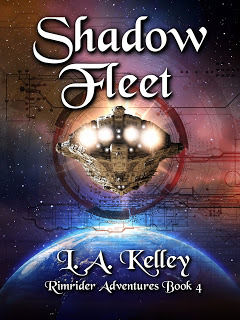 Available for Presale on Amazon
Shadow Fleet, the latest adventures of Captain Jane Benedict and the crew of the Double Dare is now available for presale. Release date is January 24, 2018.
Available for Presale on Amazon
Shadow Fleet, the latest adventures of Captain Jane Benedict and the crew of the Double Dare is now available for presale. Release date is January 24, 2018.
As the war between Freetraders and UEC ramps up, training begins for the new Shadow Fleet, but it’s far from smooth sailing for Captain Jane Benedict and the crew of the Double Dare. Old resentments simmer beneath the surface threatening to drive a wedge between Freetrader forces. Meanwhile plans are made to reenter the boneyard and locate headquarters for the new Shadow Fleet, but scavenging a shifting debris field has its own set of challenges. Dangers from the past and new ones from the present threatened the safety of Jane and her friends leaving them with only one response…
Hit’m hard, hit’m fast, and never surrender.
Buy Link
Published on January 11, 2018 05:46
December 27, 2017
Goofs, Blunders, and Big Time Boo-boos in Books.
On the cusp of a glorious New Year it’s time to reflect on all the dumb writing mistakes we’ve made in the past twelve months; dangling modifiers, an overabundance of commas, misspellings, wrong word usage. The lists go on for each of us, but fear not, we keep famous company.
 A History of Boo-boos
Some of the most famous books, past and present have had their share of problems and not even having God as an editor helps. In 1631 Robert Barker and Martin Lucas, the royal printers for Charles I, put out a new edition of the King James Bible with a teensy little error. Glory hallelujah, adultery was now not only legal, but required. The book soon became known as the Wicked Bible, Adulterous Bible, or Sinners’ Bible. All have a nice ring to them. Neither the king nor the Archbishop of Canterbury had a sense of humor and the publishers of the Wicked Bible were called to the Star Chamber and fined £300. Copies were destroyed, but a few escaped and are now highly sought after collector’s items.
A History of Boo-boos
Some of the most famous books, past and present have had their share of problems and not even having God as an editor helps. In 1631 Robert Barker and Martin Lucas, the royal printers for Charles I, put out a new edition of the King James Bible with a teensy little error. Glory hallelujah, adultery was now not only legal, but required. The book soon became known as the Wicked Bible, Adulterous Bible, or Sinners’ Bible. All have a nice ring to them. Neither the king nor the Archbishop of Canterbury had a sense of humor and the publishers of the Wicked Bible were called to the Star Chamber and fined £300. Copies were destroyed, but a few escaped and are now highly sought after collector’s items.
You’d think having won a Nobel Prize in Literature for a dang book means a letter perfect copy, but not so. There have been multiple editions of The Good Earth by Pearl S. Buck, but the first, second, and third are flawed. Page 100, line 17, describes a wall. “It stretched out long and grey and very high, and against the base the small mat sheds clung like flees to a dog's back.” Copies of the book that include the misspelling can go for as much as $9500.
 In The Adventures of Tom Sawyer, Mark Twain’s Huck Finn spoke in dialect. “Spos’n” in place of “supposing” isn’t a mistake, but hidden in the first edition is a genuine (or gen-you-wine) error. “I took the bag to where it used to stand, and ripped a hole in the bottom of it with the was.” I’m supos’n he meant the saw.
In The Adventures of Tom Sawyer, Mark Twain’s Huck Finn spoke in dialect. “Spos’n” in place of “supposing” isn’t a mistake, but hidden in the first edition is a genuine (or gen-you-wine) error. “I took the bag to where it used to stand, and ripped a hole in the bottom of it with the was.” I’m supos’n he meant the saw.
An American Tragedy by Theodore Dreiser is one of the more well-known examples of poor copy editing. It’s rife with small typos such as “if” for “it” or “to” for “too”, but some really miss the mark. On page 340 he describes people “like two small chips being tossed about on a rough but friendly sea.” My only question is Doritos or Lays?
 Modern Mistakes
Mistakes are not a thing of the past. Typos andgrammatical errors have become increasingly common. The explosion of self-publication gets a bad rap, but big-time publishers are equally guilty. The hot mess of the Twilight trilogy has so many mistakes that websites are devoted to them. George R. R. Martin’s Fire and Ice Series is rife with errors and plot inconsistencies. Even Harry Potter isn’t immune. A rare first edition with the word “philosopher” misspelled on the back cover recently sold for £43,750. The all-time Big Daddy of modern typos has to go to The Pasta Bible, published by Penguin Group Australian in 2010. The company recalled 7000 copies of the book when someone discovered a recipe for spelt tagliatelle with sardines and prosciutto told cooks to “add salt and freshly ground black people.”
Modern Mistakes
Mistakes are not a thing of the past. Typos andgrammatical errors have become increasingly common. The explosion of self-publication gets a bad rap, but big-time publishers are equally guilty. The hot mess of the Twilight trilogy has so many mistakes that websites are devoted to them. George R. R. Martin’s Fire and Ice Series is rife with errors and plot inconsistencies. Even Harry Potter isn’t immune. A rare first edition with the word “philosopher” misspelled on the back cover recently sold for £43,750. The all-time Big Daddy of modern typos has to go to The Pasta Bible, published by Penguin Group Australian in 2010. The company recalled 7000 copies of the book when someone discovered a recipe for spelt tagliatelle with sardines and prosciutto told cooks to “add salt and freshly ground black people.”
 Disregard, for a moment, any self-published books that have obviously never seen an editor’s hand. If it seems mistakes are on the rise, even in releases from major publishing houses, you’re not mistaken. Publishers used to exist for the purpose of distributing as near perfect copy as possible. Errors were met with chagrin. Not anymore. Before the recession and the onset of digital publishing, companies had armies of copy editors clutching their little red pens. Manuscripts went from editor to galley proof then revised proof and finally blue line. Each step in the process was another chance for review and correction of mistakes. To cut expenses, companies dumped droves of copy editors and then leaped on the bandwagon of digital publishing. Ebook sales soared. Expenses for book production plummeted while overall profits shot skyward. Large publishing houses such as HarperCollins, Penguin Random House, and Hachette are rolling in dough, but no one’s rehiring the editing staff. No wonder mistakes slip by. The Pasta Bible gaffe was blamed on a spellcheck error. Someone should tell the CEO of the Penguin Group you can’t rely solely on a computer and still need a sharp pair of human eyes.
Disregard, for a moment, any self-published books that have obviously never seen an editor’s hand. If it seems mistakes are on the rise, even in releases from major publishing houses, you’re not mistaken. Publishers used to exist for the purpose of distributing as near perfect copy as possible. Errors were met with chagrin. Not anymore. Before the recession and the onset of digital publishing, companies had armies of copy editors clutching their little red pens. Manuscripts went from editor to galley proof then revised proof and finally blue line. Each step in the process was another chance for review and correction of mistakes. To cut expenses, companies dumped droves of copy editors and then leaped on the bandwagon of digital publishing. Ebook sales soared. Expenses for book production plummeted while overall profits shot skyward. Large publishing houses such as HarperCollins, Penguin Random House, and Hachette are rolling in dough, but no one’s rehiring the editing staff. No wonder mistakes slip by. The Pasta Bible gaffe was blamed on a spellcheck error. Someone should tell the CEO of the Penguin Group you can’t rely solely on a computer and still need a sharp pair of human eyes.
 Egad. My Book has a Boo-boo
So what does all this mean for today’s self-published writer? First, find yourself a good editor. There are plenty out there and they can use the work. Produce the cleanest manuscript you can and stop beating yourself over the head if a typo makes it into your final work. They will. They always do. Shrug it off and submit a corrected copy and be proud of your creation. If you find a typo in a book from a major publishing house, don’t bother to send them a message. They couldn’t care less.
Egad. My Book has a Boo-boo
So what does all this mean for today’s self-published writer? First, find yourself a good editor. There are plenty out there and they can use the work. Produce the cleanest manuscript you can and stop beating yourself over the head if a typo makes it into your final work. They will. They always do. Shrug it off and submit a corrected copy and be proud of your creation. If you find a typo in a book from a major publishing house, don’t bother to send them a message. They couldn’t care less.
 A History of Boo-boos
Some of the most famous books, past and present have had their share of problems and not even having God as an editor helps. In 1631 Robert Barker and Martin Lucas, the royal printers for Charles I, put out a new edition of the King James Bible with a teensy little error. Glory hallelujah, adultery was now not only legal, but required. The book soon became known as the Wicked Bible, Adulterous Bible, or Sinners’ Bible. All have a nice ring to them. Neither the king nor the Archbishop of Canterbury had a sense of humor and the publishers of the Wicked Bible were called to the Star Chamber and fined £300. Copies were destroyed, but a few escaped and are now highly sought after collector’s items.
A History of Boo-boos
Some of the most famous books, past and present have had their share of problems and not even having God as an editor helps. In 1631 Robert Barker and Martin Lucas, the royal printers for Charles I, put out a new edition of the King James Bible with a teensy little error. Glory hallelujah, adultery was now not only legal, but required. The book soon became known as the Wicked Bible, Adulterous Bible, or Sinners’ Bible. All have a nice ring to them. Neither the king nor the Archbishop of Canterbury had a sense of humor and the publishers of the Wicked Bible were called to the Star Chamber and fined £300. Copies were destroyed, but a few escaped and are now highly sought after collector’s items.You’d think having won a Nobel Prize in Literature for a dang book means a letter perfect copy, but not so. There have been multiple editions of The Good Earth by Pearl S. Buck, but the first, second, and third are flawed. Page 100, line 17, describes a wall. “It stretched out long and grey and very high, and against the base the small mat sheds clung like flees to a dog's back.” Copies of the book that include the misspelling can go for as much as $9500.
 In The Adventures of Tom Sawyer, Mark Twain’s Huck Finn spoke in dialect. “Spos’n” in place of “supposing” isn’t a mistake, but hidden in the first edition is a genuine (or gen-you-wine) error. “I took the bag to where it used to stand, and ripped a hole in the bottom of it with the was.” I’m supos’n he meant the saw.
In The Adventures of Tom Sawyer, Mark Twain’s Huck Finn spoke in dialect. “Spos’n” in place of “supposing” isn’t a mistake, but hidden in the first edition is a genuine (or gen-you-wine) error. “I took the bag to where it used to stand, and ripped a hole in the bottom of it with the was.” I’m supos’n he meant the saw.An American Tragedy by Theodore Dreiser is one of the more well-known examples of poor copy editing. It’s rife with small typos such as “if” for “it” or “to” for “too”, but some really miss the mark. On page 340 he describes people “like two small chips being tossed about on a rough but friendly sea.” My only question is Doritos or Lays?
 Modern Mistakes
Mistakes are not a thing of the past. Typos andgrammatical errors have become increasingly common. The explosion of self-publication gets a bad rap, but big-time publishers are equally guilty. The hot mess of the Twilight trilogy has so many mistakes that websites are devoted to them. George R. R. Martin’s Fire and Ice Series is rife with errors and plot inconsistencies. Even Harry Potter isn’t immune. A rare first edition with the word “philosopher” misspelled on the back cover recently sold for £43,750. The all-time Big Daddy of modern typos has to go to The Pasta Bible, published by Penguin Group Australian in 2010. The company recalled 7000 copies of the book when someone discovered a recipe for spelt tagliatelle with sardines and prosciutto told cooks to “add salt and freshly ground black people.”
Modern Mistakes
Mistakes are not a thing of the past. Typos andgrammatical errors have become increasingly common. The explosion of self-publication gets a bad rap, but big-time publishers are equally guilty. The hot mess of the Twilight trilogy has so many mistakes that websites are devoted to them. George R. R. Martin’s Fire and Ice Series is rife with errors and plot inconsistencies. Even Harry Potter isn’t immune. A rare first edition with the word “philosopher” misspelled on the back cover recently sold for £43,750. The all-time Big Daddy of modern typos has to go to The Pasta Bible, published by Penguin Group Australian in 2010. The company recalled 7000 copies of the book when someone discovered a recipe for spelt tagliatelle with sardines and prosciutto told cooks to “add salt and freshly ground black people.” Disregard, for a moment, any self-published books that have obviously never seen an editor’s hand. If it seems mistakes are on the rise, even in releases from major publishing houses, you’re not mistaken. Publishers used to exist for the purpose of distributing as near perfect copy as possible. Errors were met with chagrin. Not anymore. Before the recession and the onset of digital publishing, companies had armies of copy editors clutching their little red pens. Manuscripts went from editor to galley proof then revised proof and finally blue line. Each step in the process was another chance for review and correction of mistakes. To cut expenses, companies dumped droves of copy editors and then leaped on the bandwagon of digital publishing. Ebook sales soared. Expenses for book production plummeted while overall profits shot skyward. Large publishing houses such as HarperCollins, Penguin Random House, and Hachette are rolling in dough, but no one’s rehiring the editing staff. No wonder mistakes slip by. The Pasta Bible gaffe was blamed on a spellcheck error. Someone should tell the CEO of the Penguin Group you can’t rely solely on a computer and still need a sharp pair of human eyes.
Disregard, for a moment, any self-published books that have obviously never seen an editor’s hand. If it seems mistakes are on the rise, even in releases from major publishing houses, you’re not mistaken. Publishers used to exist for the purpose of distributing as near perfect copy as possible. Errors were met with chagrin. Not anymore. Before the recession and the onset of digital publishing, companies had armies of copy editors clutching their little red pens. Manuscripts went from editor to galley proof then revised proof and finally blue line. Each step in the process was another chance for review and correction of mistakes. To cut expenses, companies dumped droves of copy editors and then leaped on the bandwagon of digital publishing. Ebook sales soared. Expenses for book production plummeted while overall profits shot skyward. Large publishing houses such as HarperCollins, Penguin Random House, and Hachette are rolling in dough, but no one’s rehiring the editing staff. No wonder mistakes slip by. The Pasta Bible gaffe was blamed on a spellcheck error. Someone should tell the CEO of the Penguin Group you can’t rely solely on a computer and still need a sharp pair of human eyes.  Egad. My Book has a Boo-boo
So what does all this mean for today’s self-published writer? First, find yourself a good editor. There are plenty out there and they can use the work. Produce the cleanest manuscript you can and stop beating yourself over the head if a typo makes it into your final work. They will. They always do. Shrug it off and submit a corrected copy and be proud of your creation. If you find a typo in a book from a major publishing house, don’t bother to send them a message. They couldn’t care less.
Egad. My Book has a Boo-boo
So what does all this mean for today’s self-published writer? First, find yourself a good editor. There are plenty out there and they can use the work. Produce the cleanest manuscript you can and stop beating yourself over the head if a typo makes it into your final work. They will. They always do. Shrug it off and submit a corrected copy and be proud of your creation. If you find a typo in a book from a major publishing house, don’t bother to send them a message. They couldn’t care less.
Published on December 27, 2017 03:39
November 27, 2017
Zombie 101
 You Think You Know Zombies?
Ha, you say. Of course you do. A zombie is a reanimated corpse. You may even know the word zombie originated from the Kongo word nzambi which means spirit of a dead person. It was later altered to zonbi in Haitian Creole by descendants of African slaves, and eventually became zombie. How is a person zombified? Well, that’s easy. The innocent victim is infected by a pathogen. The origin can be natural or manmade, but begins with Patient Zero. The infection spreads with a bite and then the victim develops an insatiable appetite for human flesh, particularly tasty brains.
You Think You Know Zombies?
Ha, you say. Of course you do. A zombie is a reanimated corpse. You may even know the word zombie originated from the Kongo word nzambi which means spirit of a dead person. It was later altered to zonbi in Haitian Creole by descendants of African slaves, and eventually became zombie. How is a person zombified? Well, that’s easy. The innocent victim is infected by a pathogen. The origin can be natural or manmade, but begins with Patient Zero. The infection spreads with a bite and then the victim develops an insatiable appetite for human flesh, particularly tasty brains.Wrong, wrong, wrong. That’s only the short history of zombies and like many myths, this one has some basis in fact.
 Early Zombie Lore Fear that the dead won’t stay buried is common in folklore. Many Stone Age burial sites in the Middle East had corpses interred beneath large stones. In an ancient site in Syria dating back 10,000 years, the dead were not just weighed down with heavy weights, but also decapitated—an early link to modern zombie lore. Although piles of rocks discouraged animals from digging up remains, removing grandpa’s noggin also kept him from a moonlight stroll.
Early Zombie Lore Fear that the dead won’t stay buried is common in folklore. Many Stone Age burial sites in the Middle East had corpses interred beneath large stones. In an ancient site in Syria dating back 10,000 years, the dead were not just weighed down with heavy weights, but also decapitated—an early link to modern zombie lore. Although piles of rocks discouraged animals from digging up remains, removing grandpa’s noggin also kept him from a moonlight stroll.Ancient Greeks were equally careful with their corpses. Archeologists working in Sicily unearthed a Greek necropolis called Passo Marinaro dating from 800 BC. The entombed, children as well as adults, were found in a variety of positions; staked, tied, or again weighed down by stones. According to the Greeks, certain deceased were more prone to walk among the living. These included victims of murder, a plague, or a curse. Greeks also piled on the extra big rocks for those born on unlucky days. Bad enough being killed by a plague or curse, now you had to spend eternity with a boulder on your head.
 eHarmony Head ZombieEarly hints at the development of modern zombie lore can be found in places other than the Middle East. Norse mythology contains tales of the draugr or “again walker” who like to munch on locals. They pass on their curse by biting a victim (sound familiar?), but can also have supernatural powers such as shape-shifting or entering a person’s dreams. Romania has its own native zombies with strigoi, a combination zombie/vampire. They drink blood and rise from the dead to stalk the living, generally a relative. To stop them the grave must be dug up and the head and heart removed. One way to turn into a strigoi is to die single, so some communities marry off the corpse as a preventive measure. Take that, eHarmony.
eHarmony Head ZombieEarly hints at the development of modern zombie lore can be found in places other than the Middle East. Norse mythology contains tales of the draugr or “again walker” who like to munch on locals. They pass on their curse by biting a victim (sound familiar?), but can also have supernatural powers such as shape-shifting or entering a person’s dreams. Romania has its own native zombies with strigoi, a combination zombie/vampire. They drink blood and rise from the dead to stalk the living, generally a relative. To stop them the grave must be dug up and the head and heart removed. One way to turn into a strigoi is to die single, so some communities marry off the corpse as a preventive measure. Take that, eHarmony. Liquid Zombie
Modern Zombies
Present day zombie lore has two types (three if you count the mixed drink made with rum and fruit juices.) The first is the “not quite dead” created by voodoo magic. This one has a practical social application. A family or community decides a certain individual is an annoying pain in the rear. They hire a bokur, a voodoo priest specializing in black magic. The bokur uses spells, incantations and a liberal dose of coup padre, a powder made from the poison tetrodoxin. It slows heart rate, respiration, and drops body temperature. Thinking the victim perished, the body is buried and then later removed by the bokur. The new zombie is in an addled state with memory erased and transformed into a mindless drone. All in all, an efficient method for removing undesirables from society and a win-win for both the community and the bokur. An annoying pain in the rear is gone and the bokur receives a docile servant. This type of zombie doesn’t consume flesh and is relatively harmless. He might even be happier. Leave him be.
Liquid Zombie
Modern Zombies
Present day zombie lore has two types (three if you count the mixed drink made with rum and fruit juices.) The first is the “not quite dead” created by voodoo magic. This one has a practical social application. A family or community decides a certain individual is an annoying pain in the rear. They hire a bokur, a voodoo priest specializing in black magic. The bokur uses spells, incantations and a liberal dose of coup padre, a powder made from the poison tetrodoxin. It slows heart rate, respiration, and drops body temperature. Thinking the victim perished, the body is buried and then later removed by the bokur. The new zombie is in an addled state with memory erased and transformed into a mindless drone. All in all, an efficient method for removing undesirables from society and a win-win for both the community and the bokur. An annoying pain in the rear is gone and the bokur receives a docile servant. This type of zombie doesn’t consume flesh and is relatively harmless. He might even be happier. Leave him be.The second type of zombie is a strictly Hollywood creation from screenwriters in La La Land. Patient Zero is infected by either a natural or manmade entity. Death is the result, but the corpse is reanimated by a mysterious biological process and develops an insatiable craving for human flesh. One bite from a zombie spreads the infection and chaos reigns. Although fictional, some folks take the threat of the zombie apocalypse seriously, like the Center for Disease Control in Atlanta. The CDC is tasked with investigating dangerous pathogens and their scientists are apparently endowed with a cheeky sense of humor. People don’t like to think ahead and prepare for emergencies. The CDC realized the steps to slow the spread of a dangerous viral outbreak would be the same as needed to combat a zombie apocalypse, and people might pay more attention to the latter. Official zombie apocalypse guidelines are now posted on the CDC website. They include such things as items to keep in an emergency kit and how to make a disaster plan. The site went over like gangbusters and crashed the day it went live.
 Check it out at https://www.cdc.gov/phpr/zombie/index.htm) You can even join the CDC Zombie Task Force. Proceeds go to disaster relief efforts and health programs. Now, prepare your own kit, and keep your mitts off my tasty brains.
Check it out at https://www.cdc.gov/phpr/zombie/index.htm) You can even join the CDC Zombie Task Force. Proceeds go to disaster relief efforts and health programs. Now, prepare your own kit, and keep your mitts off my tasty brains.
Published on November 27, 2017 04:52
November 14, 2017
Book Review: The Comic Book Story of Video Games by Jonathan Hennessey
 Comic books and video games are fun examples of the visual arts especially when author Jonathan Hennessey combines them in an entertaining and educational book certain to appeal to fans of both genres. Even though information comes in comic panels, this isn’t a quick and glossy overview, but rather a thoughtful and in depth exploration of the history of video games; how they got here, the state of the art, and where they’re going.
Comic books and video games are fun examples of the visual arts especially when author Jonathan Hennessey combines them in an entertaining and educational book certain to appeal to fans of both genres. Even though information comes in comic panels, this isn’t a quick and glossy overview, but rather a thoughtful and in depth exploration of the history of video games; how they got here, the state of the art, and where they’re going.Hennessey starts off with the surprising statement that computers are not a must have to make or play video games, nor are all electronic games video games. To back that up he takes readers on a tour of game development history starting with experiments with electricity in the 1800s. That leads to pre- and post-World War II and the cathode ray tube. He touches on early contributors to computer technology such as Alan Turing and how the Cold War contributed not only to computer development, but also gaming tropes.
Hacking began a lot earlier than you’d think (the 1950s.) Early hackers’ desire to understand the ins and out of computers went hand in hand with their yen to improve them and stretch the boundaries of what technology could do. Hennessey comes to the amusing conclusion that video games are themselves a hack since computers were only intended for military, government, scientific and industry use. The book is rife with stories of early pioneers such as Nolan Bushnell and Steve Wozniak along with many you never heard of such as Jerry Lawson, an early builder of arcade games. The author ends with the Xbox and Wii Minecraft and how home consoles changed the industry.
This is a fast, fun book with nicely drawn graphics. It’s as up to date as can be expected, but considering how quickly technology changes, the last entries in the book are sure to be old news soon. I received this book from Blogging for Book in exchange for a review.
Published on November 14, 2017 13:37
October 27, 2017
Go to Hell. Don't Mind if I Do
 All Soul’s Day is fast upon us when the veil between dimensions stretches thin. Before you pop over to the other side for a cold brewski, you might want to consider which hell is the right one for you. Depictions of an afterlife, particularly one for naughty folk, have been part of religious beliefs from the beginning. After this word ends, any person who says the right prayers and acts according to the dictates of those in charge gets a fast-pass to the next. A common belief is the journey; good go up to the light, bad go down to a darker realm. No surprise there. Night was scary for our ancestors. With no understandings of modern science, demons in the dark were blamed for every bad thing that happened when the sun went down. Best stay indoors and huddle around the fire.
All Soul’s Day is fast upon us when the veil between dimensions stretches thin. Before you pop over to the other side for a cold brewski, you might want to consider which hell is the right one for you. Depictions of an afterlife, particularly one for naughty folk, have been part of religious beliefs from the beginning. After this word ends, any person who says the right prayers and acts according to the dictates of those in charge gets a fast-pass to the next. A common belief is the journey; good go up to the light, bad go down to a darker realm. No surprise there. Night was scary for our ancestors. With no understandings of modern science, demons in the dark were blamed for every bad thing that happened when the sun went down. Best stay indoors and huddle around the fire.  Greeks even had a special word katabasis, meaning descent or downward to describe a journey to Hades. For the Greeks, it wasn’t always a one-way trip; sometimes the road to Hell resembled a superhighway. Although a place of fiery desolation, Odysseus managed to drop in for a nice chat with his mom, Hercules went there to rescue Theseus, Theseus was only trapped there because the dope muffed an attempt to spring Persephone. For the Greeks, the trip to Hades could have an upside. There was always the chance of snagging some mystical device, or at the very least, coming back wiser and more insightful. A quest to Hell was often a part of the hero’s journey.
Greeks even had a special word katabasis, meaning descent or downward to describe a journey to Hades. For the Greeks, it wasn’t always a one-way trip; sometimes the road to Hell resembled a superhighway. Although a place of fiery desolation, Odysseus managed to drop in for a nice chat with his mom, Hercules went there to rescue Theseus, Theseus was only trapped there because the dope muffed an attempt to spring Persephone. For the Greeks, the trip to Hades could have an upside. There was always the chance of snagging some mystical device, or at the very least, coming back wiser and more insightful. A quest to Hell was often a part of the hero’s journey. The version of Hell in Judaism can be summed up in one word: meh. Little mention is made in Judaic texts other than references to a place called Sheol that is dark and deep (naturally.) In general, there are no fixed notions of particular judgments or punishments. Another place in Judaic texts is Gehinnom, but again the views are mixed. Some scholars view it as a place of punishment and retribution, others more of a section of the afterlife set aside for introspection to review mistakes committed in life and then repent them. Don’t repent enough? Something bad is bound to happen, but details are murky.
The version of Hell in Judaism can be summed up in one word: meh. Little mention is made in Judaic texts other than references to a place called Sheol that is dark and deep (naturally.) In general, there are no fixed notions of particular judgments or punishments. Another place in Judaic texts is Gehinnom, but again the views are mixed. Some scholars view it as a place of punishment and retribution, others more of a section of the afterlife set aside for introspection to review mistakes committed in life and then repent them. Don’t repent enough? Something bad is bound to happen, but details are murky. 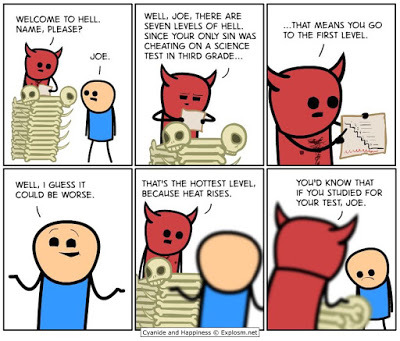 In Christian mythos, heaven and hell are ethereal planes that can’t be reached or seen by the common folk until after death. They are always characterized as “up” or “down” in no uncertain terms as if AAA designed a TripTik. The route never detours; heaven is up, hell is down, and it’s definitely one-way. Christians had no doubts about punishment. They adopted earlier pagan beliefs that Hell was a place of burning and eternal punishment reserved for the wicked. The term ‘wicked’ has relaxed over the years. Many notions of Hell can be trace to the 14th century and Dante Alighieri’s epic poem. In the section of The Divine Comedy called The Inferno, Dante described nine circles of Hell; limbo, lust, gluttony, greed, anger, heresy, violence, fraud, and treachery. Today, being consigned to hell because you snagged the last piece of double fudge chocolate cake seems unduly harsh, but gluttony meant more to folks in the Renaissance. Scarfing down all the gruel first meant the rest of the household starved to death.
In Christian mythos, heaven and hell are ethereal planes that can’t be reached or seen by the common folk until after death. They are always characterized as “up” or “down” in no uncertain terms as if AAA designed a TripTik. The route never detours; heaven is up, hell is down, and it’s definitely one-way. Christians had no doubts about punishment. They adopted earlier pagan beliefs that Hell was a place of burning and eternal punishment reserved for the wicked. The term ‘wicked’ has relaxed over the years. Many notions of Hell can be trace to the 14th century and Dante Alighieri’s epic poem. In the section of The Divine Comedy called The Inferno, Dante described nine circles of Hell; limbo, lust, gluttony, greed, anger, heresy, violence, fraud, and treachery. Today, being consigned to hell because you snagged the last piece of double fudge chocolate cake seems unduly harsh, but gluttony meant more to folks in the Renaissance. Scarfing down all the gruel first meant the rest of the household starved to death. While not all religions have an actual Hell, the up/down movement of the soul after death is often present. In the case of Hinduism, it is an ascending/descending judgment. After death the best of the best rise up and are led by divine beings to the highest, immortal heaven of Brahman. Those who led virtuous lives, but haven’t quite reached the top tier can be reincarnated according to previous actions. You can come back (down) as a person and try to live a more virtuous life. Those that reveled in sinful ways don’t end up in Hell, but do descend to a lower life form, often one that lives underground such as an insect. Tibetan Buddhism has a similar outlook. After 49 days in a limbo-type place called Bardo the soul either ascends to enlightenment or, if the soul doesn’t make the cut, it’s back down to a rebirth on Earth to try again.
While not all religions have an actual Hell, the up/down movement of the soul after death is often present. In the case of Hinduism, it is an ascending/descending judgment. After death the best of the best rise up and are led by divine beings to the highest, immortal heaven of Brahman. Those who led virtuous lives, but haven’t quite reached the top tier can be reincarnated according to previous actions. You can come back (down) as a person and try to live a more virtuous life. Those that reveled in sinful ways don’t end up in Hell, but do descend to a lower life form, often one that lives underground such as an insect. Tibetan Buddhism has a similar outlook. After 49 days in a limbo-type place called Bardo the soul either ascends to enlightenment or, if the soul doesn’t make the cut, it’s back down to a rebirth on Earth to try again.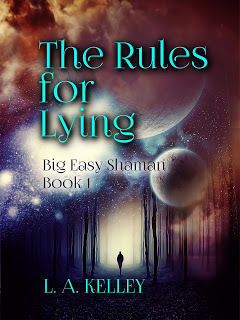 The Rules for Lying
In my new fantasy Big Easy Shaman series, I incorporate a mix of beliefs. Very bad people end up in the Lower Worlds. Yes, there are more than one, but keeping with tradition, they’re all fairly miserable places inhabited by demons, evil spirits, and all sorts of general nastiness. Terrible places to visit and you definitely don’t want to live in any of them. So the next time someone tells you to go to hell smile broadly, thank them for the fine suggestion, and politely ask which one.
The Rules for Lying
In my new fantasy Big Easy Shaman series, I incorporate a mix of beliefs. Very bad people end up in the Lower Worlds. Yes, there are more than one, but keeping with tradition, they’re all fairly miserable places inhabited by demons, evil spirits, and all sorts of general nastiness. Terrible places to visit and you definitely don’t want to live in any of them. So the next time someone tells you to go to hell smile broadly, thank them for the fine suggestion, and politely ask which one.
Published on October 27, 2017 01:00
October 15, 2017
Book Review: A Charm of Goldfinches and Other Wild Gatherings by Matt Sewell
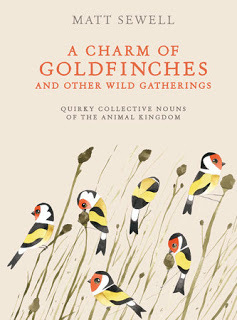 Sometimes an ordinary word just won’t do when describing clusters of animals in nature. That’s when you take the poetic approach. This little book by Matt Sewell illustrates different groups and their poetical nomenclature; a plague of rats, a crash of hippos, a murder of crows and so forth. The author is an artist and each group of animals is accompanied by a painting and a brief description on the opposing page. The descriptions are only a paragraph or two and not much to read. The real charm is the paintings. I’d hang any one of them on my wall.
Sometimes an ordinary word just won’t do when describing clusters of animals in nature. That’s when you take the poetic approach. This little book by Matt Sewell illustrates different groups and their poetical nomenclature; a plague of rats, a crash of hippos, a murder of crows and so forth. The author is an artist and each group of animals is accompanied by a painting and a brief description on the opposing page. The descriptions are only a paragraph or two and not much to read. The real charm is the paintings. I’d hang any one of them on my wall. I received this book from Blogging for Books in exchange for a review.
Published on October 15, 2017 13:46
October 13, 2017
Escape from Behruz by Judy Meadows: 99 Cent Sale
 ESCAPE FROM BEHRUZby Judy Meadows99 Cent Sale
ESCAPE FROM BEHRUZby Judy Meadows99 Cent Sale
Olivia treks through the mountains to Iran--with her baby, her puppy, her secrets, and the man she is forbidden to love.
Rashid will help Olivia and the baby escape the violence in Behruz, but he won’t let Olivia near his heart. Not again. Not after the way she trampled it two years ago.
Olivia accepts Rashid's help, but she has no interest in his heart. She’s never forgiven him for abandoning her when she needed him most. Still, she has to be careful. He mustn't learn that the baby the world thinks is heir to the Behruzi throne is actually her son. And Rashid’s.
Can they make it through the trek, sharing a tent each night, without giving in to the attraction that has always drawn them together? Can Olivia hold in the secret that could destroy her?
Excerpt “Olivia.” It had been two years since he’d seen her, but she looked the same. He stood gaping at her like the Behruzi men around him. Something in his essence reached for her, and he wanted... Never mind what he wanted. Never mind the memories that assaulted him and pulled on his heart. Losing her two years ago had almost killed him. He would never let himself be that vulnerable again. He was here for one reason, to get her out of the country. He must focus on that.She gazed back at him, her eyes big and round in a face that had gone suddenly pale.“Olivia.” He said it more loudly this time, and everyone turned to look at him. He stepped toward her, but when she cringed, he stopped. “Are you all right?”“Yes. It’s just such a surprise. What are you doing here?”“I was looking for you. What are you doing here?”She wrinkled her brow as if his question confounded her. He saw her as the circle of Behruzis must see her, and he wondered, as they must be wondering, how this tall, green-eyed foreign girl with her silky golden hair and tight-fitting jeans happened to be standing in front of the butcher shop, pale and bewildered, holding a plastic shopping bag and a chador.“Please move along,” Rashid said to the others. “I’ll take care of the young woman.” They dispersed, glancing over their shoulders as they shuffled off. Rashid stepped forward to face Olivia. “What are you doing here dressed like that? Why don’t you have your hair covered?” What are you afraid of?She stood there with her chador clutched to her breast, her eyes dazed and round. Something was wrong. This wasn’t a carefree jaunt like those she’d taken when she was a teenager. It occurred to him that she might bolt like a frightened fawn. If she pulled the chador over her head, she could lose herself among the other women on the sidewalk.Be careful, he said to himself. Go slowly. And so he softened the urgency in his voice. “What are you doing here?”“I was wearing a chador.” She lifted the fabric to show him it was right there in her arms.“Well good. Why aren’t you wearing it now? Why are you here? How did you leave the palace?”There was a glimmer of the old impish Olivia in her voice when she answered. “I snuck out like I used to do when I was younger. Abu-Khan will never miss me.”“I’m sorry, but you’re wrong about that. The whole palace is in an uproar looking for you.”“Oh no!” The blood drained from her face. “Oh, I must get back. Abu-Khan will be furious!”Could she actually be afraid of Abu-Khan? “I’m sure he’s more worried than angry. I’ll let him know you’re okay.” He took out his cell phone and dialed Nur’s number. After a moment, he said, “Tell the sultan she’s all right. Tell him I’ll have her back shortly.” He put the cell phone back in his pocket. “Okay, let’s get you to the palace. I’ll find a taxi.”“No.” She sounded like the stubborn adolescent she’d once been. “No. I have to take care of something. You go to the palace and calm Abu-Khan down. I’ll return as soon as I’ve finished with my business.”As if he could walk away and leave her there alone. “What is your business, Olivia? Can I help?”A camel loped down the street led by a barefooted man wearing a turban. Olivia watched the camel for a moment before answering. “Well, yes, actually, maybe you can.”“What can I do?”“The problem is that I have this little guy.” She separated the folds of the fabric to reveal the large, frightened eyes of a puppy. “He’s sick. I need to get him to a veterinarian. Do you know where I can find one?”“What? Where did you get a puppy?”She explained, in a disjointed story he could barely follow—about a boy on a bicycle…hippies…vomit…worms.A sick puppy! He’d been thinking she had some deep, terrible problem, something to do with her life in the palace, or maybe something to do with the revolution brewing in Behruz. But no, it was a puppy. He could help with that. The knowledge made him feel powerful and heroic, as it always had. And that made him feel the aching pull of desire, a feeling she’d made it clear two years ago he had no right to feel.
Buy Links http://a.co/4wtaG1v (Amazon) https://catalog.thewildrosepress.com/all-titles/4978-escape-from-behruz.html https://www.barnesandnoble.com/w/escape-from-behruz-judy-meadows/1125837035?type=eBook http://www.bookstrand.com/escape-from-behruz https://itunes.apple.com/us/book/escape-from-behruz/id1209878652?mt=11
 Author Bio
Author Bio
I grew up in a small town in Minnesota and now live in a small town in Oregon. Between then and now I've lived all over the world, including two years in the Middle East and over a year in Mexico.
I've had a few careers--computer systems engineer (New Jersey), fruit farmer (California), domesticate violence advocate, doula (460 births), and childbirth educator (Oregon).
I'm a wife, mom, grandma, cat lover, gardener, embroiderer, traveler, and now (yay!) writer.
Published on October 13, 2017 02:00
October 1, 2017
My New Series is Out: Big Easy Shaman, Books 1 and 2
Release day for my new Big Easy Shaman series
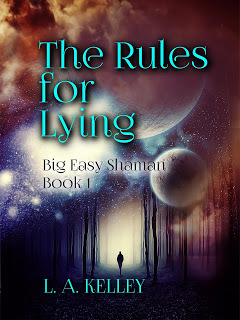 The Rules for Lying
Big Easy Shaman, Book 1
The Rules for Lying
Big Easy Shaman, Book 1
Magic isn't for sissies.
No good comes from this book. The story has magic, mayhem, theft, murder, sass talk, demons, animals committing felonies, gleeful revenge, and bad things happening to good people for no particular reason. It won’t encourage good habits and probably fine tune bad ones. The only lesson learned is don’t lie unless you know the rules. Teenager Peter Whistler lives at the Little Angels Home for Orphan Boys. Life in New Jersey is harsh in the Great Depression, but Peter has an exceptional ability to lie. He hones his talent, convinced it’s the ticket to easy fortune. He certainly doesn’t foresee the arrival of a murderous conjurer with mysterious designs on a little blind girl named Esther. Drawn into a nefarious plot to unleash a demon, Peter leads Esther and an enchanted terrier on a desperate escape to New Orleans and meets Amelie Marchand. Like all well-bred southern girls she’s trained in deadly martial arts, but with a murderous stepmother, Amelie has troubles of her own. Peter and Amelie’s one chance for survival is to head deep into the bayou and seek help from a mad shaman known as the Frog King.
Welcome to an alternate 1930s where both jazz and magic fill New Orleans’ air. Can a little luck, mystical lies, and a dash of Cajun crazy help Peter harness the power to kill an immortal demon? If not, the Depression will be a picnic by comparison when hell arrives on Earth.
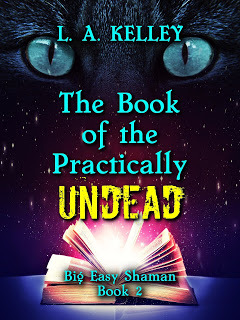 The Book of the Practically Undead
Big Easy Shaman, Book 2
The Book of the Practically Undead
Big Easy Shaman, Book 2
Life ain’t so easy in the Big Easy.
Peter settles into life in the Big Easy, but peaceful days are fleeting as new evil threatens the French Quarter. A mysterious ailment attacks people in their sleep, forcing them to commit crimes. Did someone find the Book of the Practically Undead? Legend states it has the power to turn innocent victims into obedient zombies; not quite living, not quite resting in peace. All the book needs is a new zombie master willing to walk the dark road, and in the Vieux Carré of 1930’s New Orleans, wickedness is available for a price.
As Peter investigates, he meets opposition from both the local police and The League of Professional Shamans. To cross the League means banishment for Peter and the end of his life in New Orleans as a budding shaman. On top of that, an old flame of Amelie’s reenters her life. With all these distractions, how will Peter protect the good folk of the French Quarter when evil runs amok?
Even with magic, Peter’s life ain’t easy in the Big Easy. Zombie nuns, voodoo curses, and working up the nerve to ask Amelie on a first date. Which will strike the most fear in the heart of the intrepid young shaman?
 The Rules for Lying
Big Easy Shaman, Book 1
The Rules for Lying
Big Easy Shaman, Book 1
Magic isn't for sissies.
No good comes from this book. The story has magic, mayhem, theft, murder, sass talk, demons, animals committing felonies, gleeful revenge, and bad things happening to good people for no particular reason. It won’t encourage good habits and probably fine tune bad ones. The only lesson learned is don’t lie unless you know the rules. Teenager Peter Whistler lives at the Little Angels Home for Orphan Boys. Life in New Jersey is harsh in the Great Depression, but Peter has an exceptional ability to lie. He hones his talent, convinced it’s the ticket to easy fortune. He certainly doesn’t foresee the arrival of a murderous conjurer with mysterious designs on a little blind girl named Esther. Drawn into a nefarious plot to unleash a demon, Peter leads Esther and an enchanted terrier on a desperate escape to New Orleans and meets Amelie Marchand. Like all well-bred southern girls she’s trained in deadly martial arts, but with a murderous stepmother, Amelie has troubles of her own. Peter and Amelie’s one chance for survival is to head deep into the bayou and seek help from a mad shaman known as the Frog King.
Welcome to an alternate 1930s where both jazz and magic fill New Orleans’ air. Can a little luck, mystical lies, and a dash of Cajun crazy help Peter harness the power to kill an immortal demon? If not, the Depression will be a picnic by comparison when hell arrives on Earth.
 The Book of the Practically Undead
Big Easy Shaman, Book 2
The Book of the Practically Undead
Big Easy Shaman, Book 2
Life ain’t so easy in the Big Easy.
Peter settles into life in the Big Easy, but peaceful days are fleeting as new evil threatens the French Quarter. A mysterious ailment attacks people in their sleep, forcing them to commit crimes. Did someone find the Book of the Practically Undead? Legend states it has the power to turn innocent victims into obedient zombies; not quite living, not quite resting in peace. All the book needs is a new zombie master willing to walk the dark road, and in the Vieux Carré of 1930’s New Orleans, wickedness is available for a price.
As Peter investigates, he meets opposition from both the local police and The League of Professional Shamans. To cross the League means banishment for Peter and the end of his life in New Orleans as a budding shaman. On top of that, an old flame of Amelie’s reenters her life. With all these distractions, how will Peter protect the good folk of the French Quarter when evil runs amok?
Even with magic, Peter’s life ain’t easy in the Big Easy. Zombie nuns, voodoo curses, and working up the nerve to ask Amelie on a first date. Which will strike the most fear in the heart of the intrepid young shaman?
Published on October 01, 2017 00:30
September 12, 2017
Book Review: The Massacre of Mankind by Stephen Baxter
 In cooperation with the H. G. Wells Society, author Stephen Baxter crafted a sequel to The War of the Worlds. The second book takes place fourteen years after the first invasion. England has rearmed, but its leaders gotten a little cocky. They’re sure the new weapons and military strategies can handle any trouble on the horizon, or rather, in space. Walter Jenkins, the original narrator of the first book, is on hand to issue a dire warning: the Martians will return. Their numbers will be greater and this time their diabolical plot will result in the massacre of mankind.
In cooperation with the H. G. Wells Society, author Stephen Baxter crafted a sequel to The War of the Worlds. The second book takes place fourteen years after the first invasion. England has rearmed, but its leaders gotten a little cocky. They’re sure the new weapons and military strategies can handle any trouble on the horizon, or rather, in space. Walter Jenkins, the original narrator of the first book, is on hand to issue a dire warning: the Martians will return. Their numbers will be greater and this time their diabolical plot will result in the massacre of mankind.Baxter has taken interesting liberties with the sequel. Walter is a minor character now. Instead, Julie Elphinstone steps in as first person narrator. In the original book, she was Walter’s uninspiring sister-in-law. Now divorced, Julie is a journalist, relocated to New York. She wants nothing more than to forget the past and then receives a mysterious phone call that drags her back to Europe. She returns to England with a fresh outsider’s eye, surprised at all the changes.
Baxter cleverly reimages how society would be affected by a Martian attack. World War I didn’t occur. Instead, the conflict in Europe was brief and didn’t become a world war and drag on for years. Germany increased its territory, but then made nice with Britain and became allies. (Julie returns to Europe on the still-floating Lusitania.) Instead of Scouts, Lord Baden-Powell has the Junior Sappers, children digging defensive trenches and rolling bandages. The Suffragette movement was outlawed, women still don’t have the right to vote. On the other side of the pond, the US, ignored by the Martians last time, maintains its isolationist policies. Will they be dragged into the conflict this time? Will the next Martian attack encompass the whole world?
You betcha. If you liked the verbose tone of the original story, this one will appeal. The book is nearly 500 pages with a ton of description and a multitude of characters. If you prefer more action oriented tales and less elaborate world building, this isn’t for you.
Quibbles and BitsThe geographic detail is impressive, but it would have been nice to include a map, especially for the part of the story taking place in England. Julie travels a lot, but I’m never sure where she is in relation to the Martians or how far London is from the action.
Although the story is first person it jumps around quite a bit. It’s written as Julie’s book published after the war. Her story is ‘real time’ and focuses on how she became a key player in Walter’s secret plot to stop the aliens. Along the way, she adds other peoples’ accounts. The oddest part of the narrative is the lack of tension. As you meet each person, you know exactly who lives and who dies. Julie blabs their future saying she found out later this person was killed at such-and-such a place or this person made it through.
The ending leaves a lot of loose threads and is definitely set up for a sequel.
I received this from book from Blogging for Books in exchange for a review.
Published on September 12, 2017 14:55
August 31, 2017
New Release Spotlight: Consent of the Governed by Bernard LoPinto
 Available September 1
Available September 1
Consent of the Governed presents an America ruled by a president whose blundering has thrown the nation into economic depression, where citizens are threatened by international terrorists and Red Shirts—government thugs—who keep the populace in line. In the state of emergency, the president has declared martial law and suspended the Constitution and free elections. Sid and Annie Winthrop are an elderly couple who have sworn to take revenge on the Red Shirts for murdering their son. Victor and Brooklynn are Red Shirts, true believers who are confronted with the dark underside of governmental control. When these couples are thrown together, they both come to understand what is real.
Excerpt The clock outside Coaltown National Bank read 3:07 AM, and then flashed forty-seven degrees. Alone on the Main Street sidewalk, lit only by the electric sign in the window of the hardware store and the one street light that still worked, Sid Winthrop heard the Troopers in the alley before he saw them. Four Red Shirts. Tall, young. Looking for trouble, a victim. He slipped Chloe’s leash into his right hand. The young pit bull made a low growl.
“We got this, Big Girl.” Sid unbuttoned his long leather coat and fingered the grip of his suppressed Heckler and Koch USP .45. Old men could look for trouble, too.
They came quickly and surrounded him, nightsticks in hand, as was their training. The biggest one, the squad leader—helmeted, six-four, two-fifty, could have been a college football player—took a stance directly in front of Sid, nightstick at the level of Sid’s face, blocking the way if he should try to run. Sid didn’t feel like running.
Buy Link Wild Rose Press Amazon
 Author Bio
In writing Consent of the Governed, as in my other work, I draw heavily upon my years in Pentecostal ministry and my background in correctional education. It may seem strange that religion and prison are closely linked in my psyche, but both experiences have taught me to value freedom of thought and expression. Both prison and religion set about stunting one’s individuality and personal growth.
Author Bio
In writing Consent of the Governed, as in my other work, I draw heavily upon my years in Pentecostal ministry and my background in correctional education. It may seem strange that religion and prison are closely linked in my psyche, but both experiences have taught me to value freedom of thought and expression. Both prison and religion set about stunting one’s individuality and personal growth.Besides prisons, the bulk of my career has been in education, teaching in the inner-city and Job Corps, the suburbs, and a few rural areas. In between, I’ve spent time in retail, professional photography, and any other side hustle I could pick up. Along the way, I’ve earned a Master’s in Education and a Certificate of Advanced Study in Education Administration to go along with my BA in English.
I write from a place where the “good” people aren’t so good, and one’s best friends can be the “worst” people in town. I don’t trust the ones who put their spirituality up front; those people make for some of my best comedy. I look for the ones who live the spirituality they don’t flaunt around town; they aren’t many, but they’re the real people. Between a two-bit saint and a stand-up sinner, I’ll take the sinner every time.
Published on August 31, 2017 01:30



